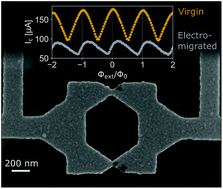Nano-SQUIDs with controllable weak links created via current-induced atom migration†
Abstract
As the most sensitive magnetic field sensor, the superconducting quantum interference device (SQUID) became an essential component in many applications due to its unmatched performance. Through recently achieved miniaturization, using state-of-the-art fabrication methods, this fascinating device extended its functionality and became an important tool in nanomaterial characterization. Here, we present an accessible and yet powerful technique of targeted atom displacement in order to reduce the size of the weak links of a DC nano-SQUID beyond the limits of conventional lithography. The controllability of our protocol allows us to characterize in situ the full superconducting response after each electromigration step. From this in-depth analysis, we reveal an asymmetric evolution of the weak links at cryogenic temperatures. A comparison with time resolved scanning electron microscopy images of the atom migration process at room temperature confirms the peculiar asymmetric evolution of the parallel constrictions. Moreover, we observe that when electromigration has sufficiently reduced the junction's cross section, superconducting phase coherence is attained in the dissipative state, where magnetic flux readout from voltage becomes possible.



 Please wait while we load your content...
Please wait while we load your content...